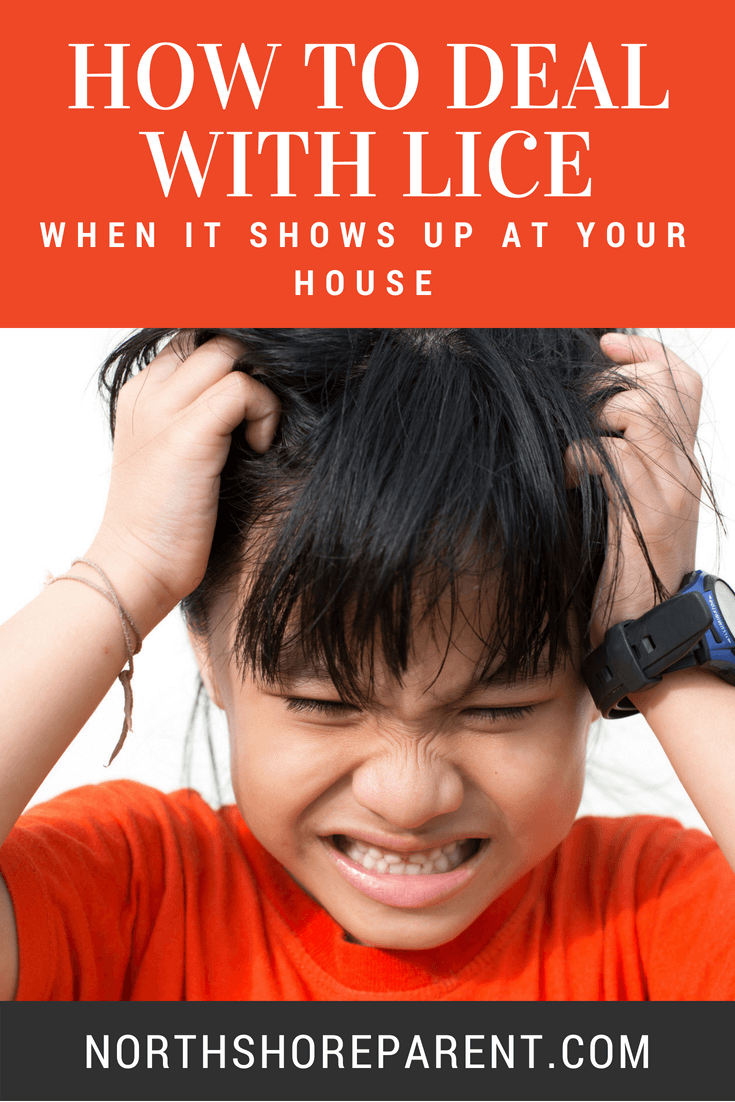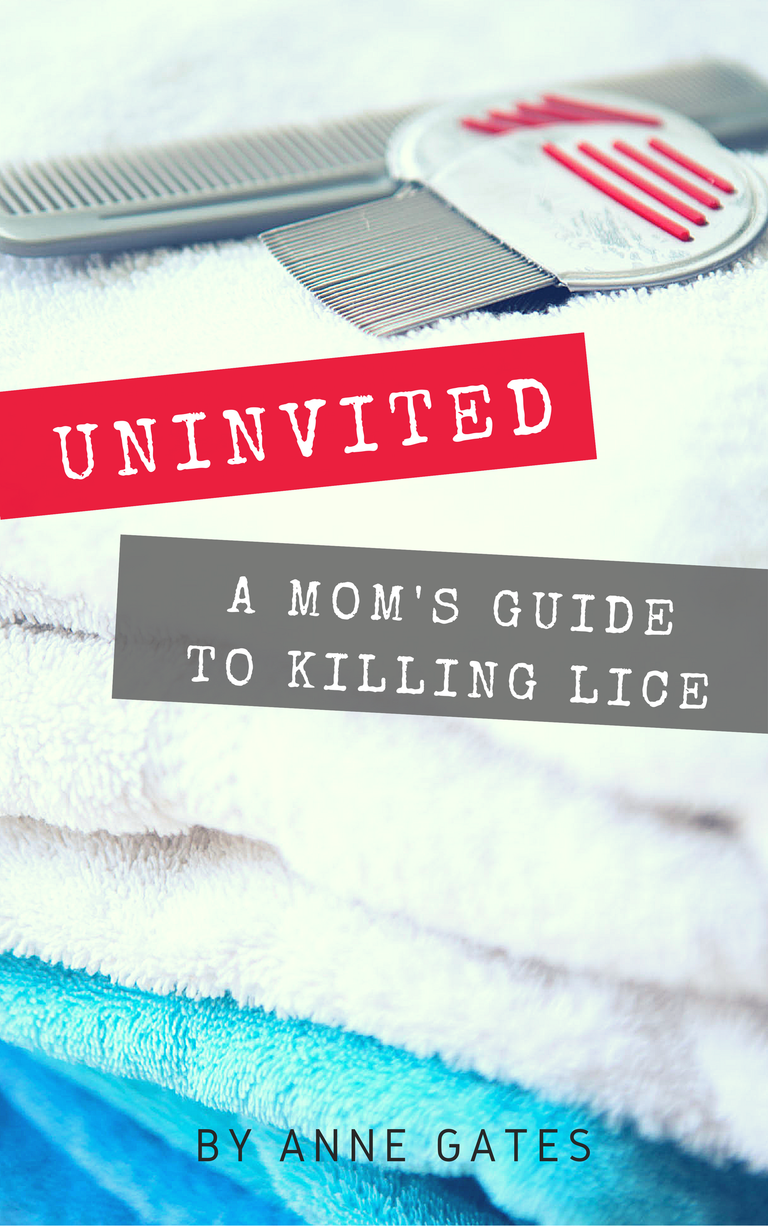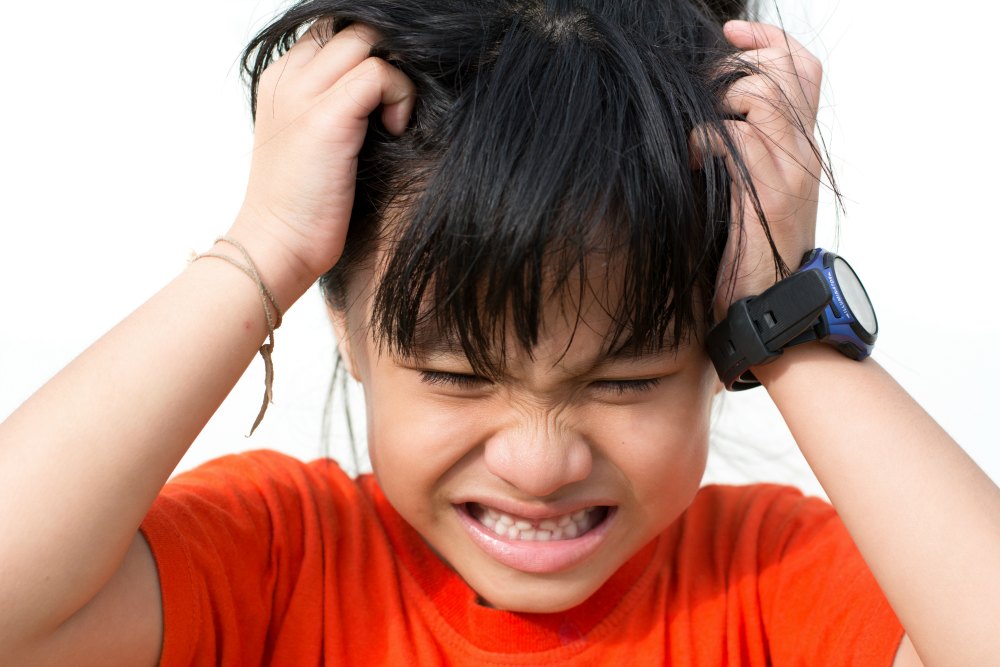LICE-A-PHOBIA
I’m itching as I type. Just the thought of tiny parasites crawling on myself and my children is enough to make me shave all of our heads. That itching sensation catches hold of me each time the dreaded lice note comes home from school. On occasion, not one but two of my kids have come home with lice notes–a kindergartener and a fifth grader. I was doubly itchy. And whenever my kindergartener is standing in carpool line waiting for me with his nap mat in hand and it’s only midweek, I don’t even need to see the note. I start scratching away at my scalp before he even climbs in my car. It’s lice-a-phobia and I’ve got it bad. As soon as my kids got home and I saw those notes in their folders, I combed all of the heads in the house, called a professional lice-checking company to double check the two heads that came home with the lice notes, and was able to breathe easy…for now.
CLOSE ENCOUNTERS WITH TINY CRITTERS
I think I suffer from PTSD due to our first, and so far only, true encounter with lice back in February of 2014. My then first grade daughter appeared in my kitchen one school morning scratching away at the back of her head. Even then, any time I saw scratching I got suspicious, so I took a look and saw a lot of redness and irritation, and some VERY tiny, white specks. I just knew it had happened–it was THEM–it was time to face my fears.
First, I forbad my husband to go to work that day because I just could not face this alone. I promised then and there that if we were ever face-to-face with alligators, his greatest fear, I would be there for him. Lice was mine and I needed him by my side, comb in hand. He went to the drug store and bought an over-the-counter chemical treatment. We treated my daughter’s hair, as well as the hair of my other two children. Then I began to comb. I combed and combed and combed until I thought I had them all. Then my husband, who is far more thorough and detailed then I am, combed more and found more. Bugs, eggs, dandruff, and dirt–you name it, we found it. When we thought we were finished, we checked our other children’s heads. They seemed to be clear, so we began collecting their bedding and belongings and running everything through the washing machine and dryer. We filled at least 6 garbage bags with stuffed animals and hair accessories, which we sealed off for two weeks.
As an extra precaution, we decided to call in the professionals. We found a company called “Critter Cure” and they were able to come to our house that afternoon. Beth Edwards, owner of The Critter Cure, has her Bachelors and Masters in social work, as well as experience in healthcare, education, and motherhood. She explains that they use “a chemical-free 5 step removal process which is done with systematic combing to eradicate the infestation.” The cost is based upon the level of treatment. Basically, it costs $25 per head for a thorough lice check, and $100 per head for anyone they needed to treat for lice. For our family of five, whose heads had all been treated, combed, and triple checked, we figured that would total $125. Although not specifically line-itemed in our budget, it was a cheap price to pay for peace of mind.
When the lice lady arrived I could have hugged her–but I didn’t just in case I had lice. She began combing through my first grader’s hair and we watched as she continued to pull out live bugs and eggs. Whatever we had done, it was not enough. She found lice in all of the children’s hair, as well as in mine. The price tag suddenly got quite a bit steeper, but we haven’t seen those little creatures since, and she shared some things that I hope will help us in the future.
LESSONS LEARNED
First, Edwards says that the leading over-the-counter chemical treatments “are only about 45%-75% effective at killing lice and 0% effective at killing nits” because “lice have developed a resistance to these products.” This was a very enlightening lesson to me because I think many parents believe (as I did initially) that they can treat their children with one of these products, and send them back to school the next day with a clean bill of health and a clear-conscience. The instructions with these products are very specific and include leaving the treatment on for exactly 10 minutes, combing through the hair, and repeating the treatment in 5-7 days.
Second is that you can NOT count on the combs that come with some of the lice treatments on the market. The gaps in some of these are large enough for nits to slide right through, and if it’s plastic rather than metal it will likely break with the repeated combing. Although I’m sure there are multiple brands that work, a personal friend of mine (and lice conquering champion) highly recommends (affiliate link) the Nit Free Terminator Comb. With almost 2,000 reviews on Amazon and just under five stars, clearly she’s not alone.
Third, repeating the combing about a week after the initial combing is essential. So many parents go through the misery of that first encounter–following all of the necessary steps–and then forget to repeat the combing after about 5-7 days to be sure to catch any new lice that have hatched. They then have to start from square one when the infestation returns.
Fourth is to use a bright light. I was amazed at how much more the lice lady was able to see using her lamp than I could see using my regular kitchen lighting. An adult louse is about 3 millimeters in length – about 1/8 of an inch–and the eggs are about 0.8 millimeters long. Those suckers are hard to see! You need that bright light, and perhaps even a pair of magnifying glasses.
The bottom line is, regardless of your method for ridding yourself of these pests–be it a pricey prescription, over-the-counter chemical treatment, or a home remedy like death by mayonnaise suffocation–the key is in the combing and the consistency. Use a strong comb, a bright light, and repeat each week for three weeks until they are gone. If the thought of all of this overwhelms you, phone a professional. Edwards says that there are two locally owned companies with comparable rates, and another National company that is a lot more expensive. The Critter Cure sees an average of 3-5 cases per day, with the majority of time being spent on treatments and follow-ups, so if you are dealing with lice, you are not alone.
SO SMALL YET SO SCARY
Lice do not spread diseases nor do they inflict pain (unless the scratching is severe enough), so why are they so scary? For me, at least when a child comes home vomiting, I know it’s usually a 24 hour thing. One day home from school, a sleeve of saltines, and a half gallon of Gatorade later, they are back to normal. With lice it’s different. First of all, chances are that once you know you have it, you’ve already had it for two to three weeks and spread it to an unknown number of others. Second, lice are itty-bitty bugs that make their homes in your head and feed on your blood–need I say more? Then there’s the clean-up aspect. Again, unlike the throw ups where you may have to wash sheets a few times, lice demands a litany of washing, drying, and bagging any clothing, bedding, hair accessories, stuffed animals, etc. It makes me want to have a big bonfire and just start from scratch with my kids’ clothes and belongings.
NO NEED TO BURN YOUR BELONGINGS
“Focus your attention more on your child’s head rather than your house. People tend to want to throw everything away and this expense is not needed. Lice are parasites that depend on human blood for survival. A louse cannot live without a host for 48 hours,” explains Edwards. She suggests washing and drying bed linens, vacuuming furniture and carpet, sanitizing hair supplies, and bagging other possibly contaminated objects for two weeks. The Center for Disease Control lays out the following specifications to avoid further infestation once all heads in the household are cleared of bugs and eggs:
- “Machine wash and dry clothing, bed linens, and other items that the infested person wore or used during the 2 days before treatment using the hot water (130°F) laundry cycle and the high heat drying cycle. Clothing and items that are not washable can be dry–cleaned sealed in a plastic bag and stored for 2 weeks.”
- “Soak combs and brushes in hot water (at least 130°F) for 5–10 minutes.”
- “Vacuum the floor and furniture, particularly where the infested person sat or lay. However, the risk of getting infested by a louse that has fallen onto a rug or carpet or furniture is very small. Head lice survive less than 1–2 days if they fall off a person and cannot feed; nits cannot hatch and usually die within a week if they are not kept at the same temperature as that found close to the human scalp. Spending much time and money on housecleaning activities is not necessary to avoid reinfestation by lice or nits that may have fallen off the head or crawled onto furniture or clothing.”
- “Do not use fumigant sprays; they can be toxic if inhaled or absorbed through the skin.”
TIPS FOR PREVENTION
If there were a guaranteed way to definitively protect your family from infestation, the inventor would be a billionaire and my personal heroine. At this point, there does not seem to be any such product. However, there are a few tips that may help parents to breathe a bit easier when sending kids out in public:
First, lice like clean hair. I have talked to parents who douse their child’s hair with hair spray, mousse, or other sprays that claim to prevent lice. I have tried a few brands of these sprays for my own sanity, and I douse my kids with them every morning. I also know there are parents who only wash their kids’ hair once per week to keep these little lice monsters at bay. Again, none of these is fool-proof but it makes me feel like I’m being proactive.
Second, lice cannot fly. They cannot jump. They can spread easily from head to head by direct or indirect contact. So if your child’s head touches the head of another infected child, they can get lice. A louse can climb from one child’s nap mat to another’s. And then there’s my personal pet peeve–crazy hat day. My kids always get a lecture the morning of crazy hat day–when it comes to hats and hair accessories, sharing is not caring. Younger kids are particularly susceptible because they have less need for personal space, so there’s more opportunity for lice to travel from one little head to the next. I don’t care how beautiful my daughter’s hair is, our house rule is that if it can be pulled back, it must be pulled back in a ponytail, braid, or bun.
Last, check your child regularly. Think of it as a public service. It is a pain. It requires wetting and conditioning your child’s hair, and usually a good bit of whining. Sometimes the kids whine, too. Try putting on a movie to distract them from the monotony of combing. If you know they have been in contact with someone who has lice, or if you have seen them scratching away at their scalp, get out your comb and search their hair section by section under a good light. Even if you don’t find any evidence of lice, repeat the process weekly if your child is returning to the same place where the lice were reported. Edwards says, “If you find nits and/or lice on your child, act quickly. Make sure, however, you find an effective way to combat the problem. By doing this you are not spinning your wheels and dealing with the problem for months. Lice can be very tricky and difficult to get rid of.” Adult lice lay about 8 eggs per day, so if a lice infestation is typically not realized until it’s been present for 2-3 weeks, waiting to treat means your problem is literally multiplying by the hundreds. Catching it early makes treatment a lot easier and may save other families from infestation (as well as saving yourself from re-infestation).
DON’T POINT FINGERS
Unfortunately, lice are just a part of life. If you get lice, there’s not need to feel guilty or dirty – the itching sensation is bad enough. Don’t point fingers at other parents whose children may have been infested before yours. As a pediatrician of mine once said, “If you point a finger at someone else, there’s always a finger pointing back at you.” In other words, your child got lice from someone then, chances are, someone else’s child probably got lice from yours. No one carries these critters around intentionally. We just need to put our best foot forward towards prevention so that we can all live the dream of lice-free lives.

A note from the editor: if you don’t have room in your budget for professional lice treatment, my friend Anne has written an e-book about her lice horror story and she documents exactly how to treat it at home. You can purchase that here (affiliate link):

Lynne
Latest posts by Lynne (see all)
- What Should You Do with Leftover Halloween Candy? - November 2, 2022
- Haunted Houses on the Northshore {and Beyond} - September 28, 2022
- Jazz in the Vines {A Review} - September 23, 2021


